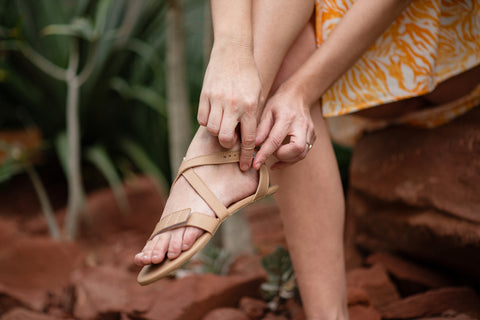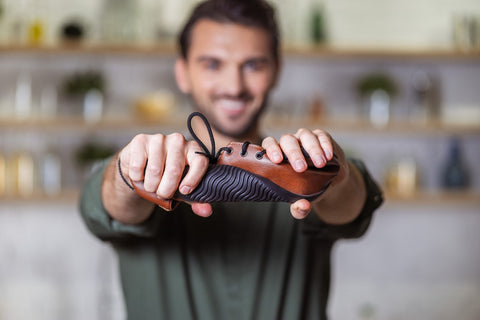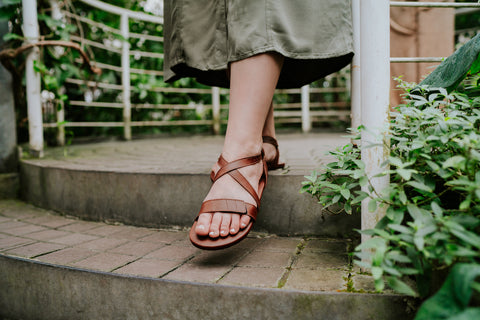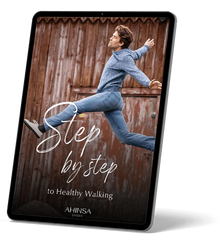Fallen arch: how to recognize it and how to cure the feet?
What is a fallen arch? When the muscles and the brain aren’t working together
For 2 million years, we humans have been running barefoot. We didn't have cushioned shoes. So what naturally cushioned our steps? The foot arch. A total of 26 bones, 33 joints and 18 muscles form an arc that acts like a spring when you step down. That is, unless it collapses.
As humankind began to put on stiff and narrow shoes, we stopped stimulating and using the muscles in the arch. This is a problem, because our brains quickly forget how to actually use them. Tension in the muscles decreases, they relax, and the arch collapses. A flat foot develops and problems ensue.

What are the symptoms of a fallen arch? From swollen feet to back pain
There are different stages of flat feet. That’s why the symptoms also vary, and sometimes it takes years before they become evident.
When a fallen arch occurs, what are the symptoms? The most common ones include:
- Swelling of the feet
- Foot fatigue after walking
- Arch pain
- Foot pain
- Pain that spreads higher up the leg
- Cold or burning feet
Knee, hip, or even back and head pain can occur. The human body is interconnected: when you throw one part out of balance, the alignment of the whole system changes. This means that the position of the feet can trigger pain, even in the cervical spine.
How to recognize a fallen arch? Try a home examination
The next time you take a shower, don't wipe your feet after you get out and step directly onto the dry floor. Then look at your footprint. What does it look like?
When the arch is healthy and well-arced, the foot touches the ground only at these points:
- the toes
- the foot under the toes
- the outer side of the foot
- the heel
The impression is nicely outlined like in the image. If you see a full oval instead, you probably have a fallen arch. For clearer results, you can try making a footprint on paper with paint.
An extra tip: Align the ankle. The problem is often not in the arch, but in an everted ankle. Stand in front of the mirror and check that your ankles are in line with your foot. If not, straighten them – as if you’re pulling them upwards. What happens to the arch when you straighten your ankle?
How does a doctor recognize a fallen arch?
Doctors and physiotherapists use a podoscope. This device shows what part of the foot is touching the ground. But be careful – a full impression doesn’t necessarily mean you have a fallen arch.
"One of my patients had a completely flat foot according to the impression. But, in reality, the arch was working perfectly. The patient was a rope-walker, and that’s why the bottom of the foot gained muscle and appeared to be flat," says physiotherapist Lukáš Klimpera.

The podoscope captures where the foot touches the ground.
So when should you see a doctor? Any time you’re troubled by any of the problems mentioned above. Pain and frequent swelling are signs that something is wrong in your body.
The most common cause of a fallen arch? The wrong shoes
The arch is natural. So how is it possible that 20-30% of people have a fallen arch? It's our own fault.
Or, more precisely: The shoes are to blame.
Barefoot walking stimulates the foot and activates the muscles. When we close the foot into a stiff and narrow shoe with a thick sole, the foot loses stimuli. Gradually, we stop sensing it. The muscles weaken and the arch collapses.

Because of thick soles, the feet lose stimuli. Choose shoes that don't isolate the feet – like the ones in this photo.
The trouble is that we've been wearing shoes since our childhood. We even put slippers on the smallest of children. Thus, we learn from an early age that we don't actually need the muscles that form the arch.
In addition to the wrong footwear, the causes of fallen arches also include:
- genetics, a tendency for loose ligaments and hypermobility
- improper stride
- overloading the feet
- overweightness
The arch also often falls in pregnancy or menopause.
How is a fallen arch treated?
Your physiotherapist or orthopedist will probably recommend two treatments:
- Exercises
- Orthopedic insoles
Exercises will teach you to sense the foot and arch. They activate and strengthen the muscles that make up the foot arch. With special exercises for the arch, you’ll learn how to regain control of the muscles and engage them in movement like nature intended.
The shape of an orthopedic insole artificially creates and supports the arch. But, it can actually have the opposite effect. Artificial support means that the muscles don't have to work, and therefore they become even weaker, making the problem worse.
"There are special diagnoses where an insole is the appropriate solution. The insole also helps relieve the patient from pain. However, it’s not enough on its own, because it only passively supports the foot," says Lukáš Klimpera.
The most effective treatment for flat feet? Barefoot walking and healthy shoes
Here’s the good news: You have the ability to rebuild and reactivate the arch. Start by freeing your feet and allowing them to move naturally.
Walk barefoot in the yard or outdoors. Feel the world beneath you and seek out interesting surfaces like pebbles, sand or grass. You're stimulating your feet and engaging muscles your brain may have forgotten about.
To activate the foot naturally during normal walking, choose healthy shoes that allow you to do so. When choosing shoes for flat feet, focus on the following:
- A wide toe box. A classic shoe tip constricts the toes together – and it’s these very toes that help form the transverse arch.
- A flexible sole. The sole should copy your movement, not restrict it.

Healthy shoes are flexible so they can copy your movement.
Avoid putting shoes on young children as much as possible. If necessary, aim for shoes that respect the natural shape of the foot. Classic sneakers with a narrow toe are harmful to a child's foot because they restrict its development.
Barefoot shoes and fallen arches: a good idea, but be careful when starting out
Barefoot walking is the best exercise for a fallen arch. So what about walking in barefoot shoes?
In good barefoot shoes, you’ll be walking just like you would when barefoot. Your feet naturally move and strengthen in them. That's why barefoot shoes can help people with a fallen arch.

Imagining ugly orthopedic footwear? Think again – barefoot shoes can be stylish. Like these sandals.
But there's a catch. Stiff, narrow shoes have changed the way people walk. We step down hard on our heels, and we could hurt ourselves in shoes with thin soles.
That’s why you should start slowly with barefoot walking. Make sure you’re stepping down sensitively. Practice on soft surfaces, like grass.
An extra tip: You can easily practice healthy walking with the e-book Step by Step to a Healthy Stride. You can download it for free.
Don't want to be watching every step you take, or feeling every pebble beneath you? Choose shoes from the Comfort line. They have a wide toe box and a flexible sole like the barefoot version. But thanks to layer of Technogel, they’ll soften your steps.
Healthy exercises for feet with a fallen arch
➡️ Stroking
Simple stroking will awaken weakened muscles. The brain has stopped sensing that it has these muscles and that it can use them.
Stroke the soles of the feet, instep, ankle and lower leg.
➡️ Toe and ankle exercises
The arch is adjusted, among other things, by the position of the toes and ankles. These simple exercises will help you activate them.
Take your time and do the exercise very slowly and consciously – ideally in conformity with your breathing. This way, you’re exercising not only your ankles, but also your brain, which needs to remember new movement patterns.
Try extending and retracting the foot:
- With the heel in place, pull your toes towards it. Release.
- With the toes in place, push the heel towards them. Release.
You can also engage your hands:
- Intertwine your fingers and your toes. This helps to adjust the position of your toes and activates the transverse arch.
- Or use your toes to "grip" your fingers. Pull gently with your hand in the opposite direction. By doing this, you’re helping to form the transverse arch.
➡️ Exercise on the balance trainer
The rounded shape of the exercise trainer helps adjust the arch of the foot – this is our half-cylindrical balance trainer. How do you exercise on it?
For example, try this exercise on both the rounded and straight sides:
- Stand on the balance trainer.
- Adjust the arch, the position of the ankle and the entire lower limb so that they’re all aligned.
- Put your weight on the standing foot. At first, you can just slightly take your weight off the other foot – later you can stand on just one foot.
- Try to keep the correct position (foot, ankle and whole leg in one line).
- Later, you can close your eyes, do a squat or walk back and forth on the trainer.
Tip: Download the e-book written by a physiotherapist
Browse the e-book Step by Step to Healthy Walking, written for you by physiotherapist Lukáš Klimpera. You'll learn the most common mistakes and you can try out simple exercises to help you move naturally and comfortably.
With just a little practice, you will soon switch the "walking" program in your brain into a new, healthy and joyful mode.
The e-book can be downloaded for free.

Free feet are happy feet. Indulge them in liberating shoes
When treating a fallen arch, the most important thing is to always resolve the reason that the arch is collapsing. And that reason is usually the wrong shoes.
Start by getting a pair of healthy shoes. Ones that will free you from physical therapy appointments.



















